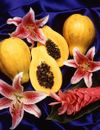You say "papaya", I say "pawpaw"
 The pawpaw I ate today was delicious.
The pawpaw I ate today was delicious.
(Click thumbnail to enlarge)
'Pawpaw', that's what it's called in Australia, but in most countries Carica papaya is called 'papaya', and outside of this country 'pawpaw' refers to Asimina triloba, a similar-looking relative of the custard apple and native of North America. Interestingly, in some islands of the West Indies they also get the name right. The yellow fruit I tucked into is known as 'pawpaw' there too, mon.
The Aussies think the Yanks have got it wrong, and the Yanks think we're nuts. So how did the confusion arise? That's not a rhetorical question; I'd really like to know.
The yummy pawpaw I ate today came from the garden; the ones in the picture came from United States Department of Agriculture. A little-known and very pleasing fact is that, unless otherwise made clear, images from USA government websites are in the public domain. Since I only have a webcam with which to take a (grainy) digital picture, the US pawpaw (sorry, papaya) will have to do. I also admit that the ones outside my door aren't quite as perfect as the ones here displayed. But they sure taste good!
Perhaps I should bow to the North American nomenclature, because the ancestors of whatever it was I ate today are believed to have originated there. In southern Mexico to be precise, which is still North America regardless of how many times one hears Mexico referred to as a Central American country, something that drives Mexicans loco.
From their Aztec home, seeds of this wonderful fruit spread around the world to other places were the climate is warm -- there are records of them being taken to Panama and then the Dominican Republic before 1525, and seeds were sent from India to Naples in 1626.
Our plant has folk medicine applications in many countries; as one website says: "In tropical folk medicine, the fresh latex is smeared on boils, warts and freckles and given as a vermifuge. In India, it is applied on the uterus as an irritant to cause abortion. The unripe fruit is sometimes hazardously ingested to achieve abortion. Seeds, too, may bring on abortion. They are often taken as an emmenagogue and given as a vermifuge. The root is ground to a paste with salt, diluted with water and given as an enema to induce abortion. A root decoction is claimed to expel roundworms. Roots are also used to make salt."
It's fitting that the plant that is so associated with tropical climates all around the world (and which almost but not quite thrives in sub-tropical ones like at Sandy Beach), has lent its name to an online interest group, The Green Papaya, which is all about South-East Asian culture.
The moon's full, the sky is like cut crystal after days of clouds and rain, and today a stiff wind blew straight from the east onto Sandy, bringing with it quite a few bluebottles that washed up on the sand; a 30-cm pink-tongue wandered up close to the Ponderosa this afternoon.
And about bluebottles, pink-tongues and all sorts of colourful things, we'll have more to report, someday, sometime, somewhen in Sandy Beach Almanac.
Late tonight I went to pay homage to Selene the Moon. I stepped onto windswept Sandy amid darkness as one of the few big billowy black clouds raced before her face. The moon shot white rays from behind the cloud; I looked up to the south end where only the sandhill was glowing eerily at a distance. Then, suddenly, bright white light illuminated all the sand and ocean, the trees and the headland, as though someone turned on the lights. I love this place, and my life, more with every passing day and every passing cloud.
Time for bed. Bright blessings to all.



















0 Comments:
Post a Comment
<< Home